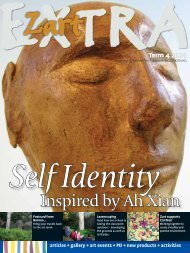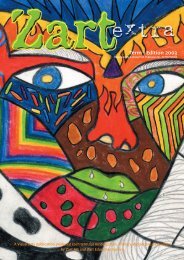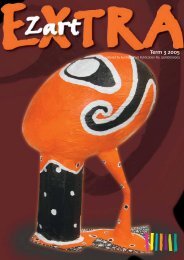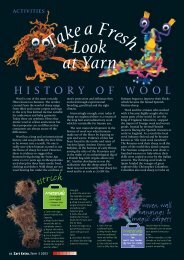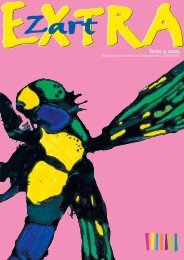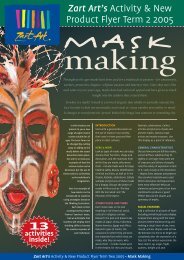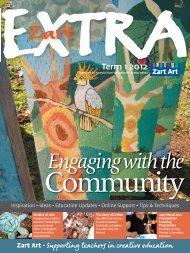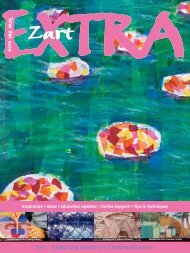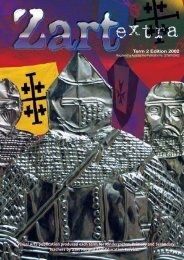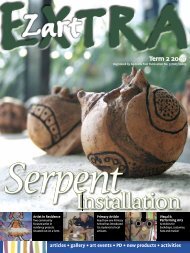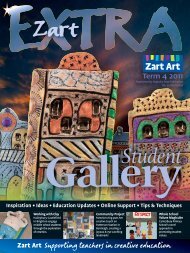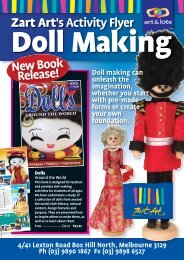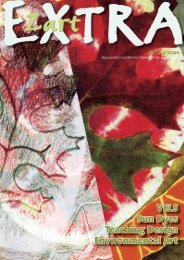A Visual Arts publication produced each term for ... - Zart Art
A Visual Arts publication produced each term for ... - Zart Art
A Visual Arts publication produced each term for ... - Zart Art
Create successful ePaper yourself
Turn your PDF publications into a flip-book with our unique Google optimized e-Paper software.
Term 3 Edition 2002<br />
Registered by Australia Post Publication No. 327687/00003<br />
A <strong>Visual</strong> <strong><strong>Art</strong>s</strong> <strong>publication</strong> <strong>produced</strong> <strong>each</strong> <strong>term</strong> <strong>for</strong> Kindergarten, Primary and Secondary<br />
T<strong>each</strong>ers by <strong>Zart</strong> <strong>Art</strong> and <strong>Zart</strong> Education Service.
Front Cover:<br />
McKinnon Secondary College<br />
<strong>Zart</strong> <strong>Art</strong><br />
PO Box 1136<br />
Box Hill Vic Australia 3128<br />
4/41 Lexton Road<br />
Box Hill North Vic 3129<br />
Ph: (03) 9890 1867<br />
Fax: (03) 9898 6527<br />
Internet: www.zartart.com.au<br />
Email: zartart@zartart.com.au<br />
Hours:<br />
8.30am-5.00pm Weekdays<br />
8.30am-12.00 noon Saturday<br />
<strong>Zart</strong>works<br />
PO Box 1136<br />
Box Hill Vic Australia 3128<br />
3/41 Lexton Road<br />
Box Hill North Vic 3129<br />
Ph: (03) 9890 5110<br />
Fax: (03) 9898 6527<br />
Internet: www.zartart.com.au<br />
email: zartart@zartart.com.au<br />
Hours:<br />
9.00am-5.00pm Weekdays<br />
9.00am-12.00 noon Saturday<br />
<strong>Zart</strong> <strong>Art</strong> School &<br />
Wholesale Supplier<br />
<strong>Zart</strong> <strong>Art</strong> offers an extensive range of resources,<br />
art materials, craft and technology supplies. You<br />
will find competitive prices and efficient and<br />
quick service.<br />
<strong>Zart</strong>works Retail Shop<br />
<strong>Zart</strong>works have all your art and craft needs<br />
catering <strong>for</strong> both beginner and professional<br />
artists. You can select from a wide range of visual<br />
arts, craft and graphic supplies. Browse at your<br />
leisure or seek assistance from our experienced<br />
staff.<br />
<strong>Zart</strong> Student’s Gallery<br />
The gallery features art works made by children<br />
from Prep to Year 12, from all around Victoria.<br />
Schools can arrange <strong>for</strong> children to visit the<br />
gallery, analyse the works of their contemporaries<br />
and then make a relevant piece of their own art<br />
work in our workshops with an art consultant.<br />
The gallery is also open to the public <strong>for</strong> viewing,<br />
during opening hours free of charge.<br />
<strong>Zart</strong> Education Service<br />
<strong>Zart</strong> Education Service provides hands on<br />
professional development workshops <strong>for</strong> Primary<br />
and Secondary t<strong>each</strong>ers, as well as Kindergarten,<br />
LOTE t<strong>each</strong>ers and Librarians. <strong>Visual</strong> <strong><strong>Art</strong>s</strong><br />
workshops are regularly held at <strong>Zart</strong> and in<br />
metropolitan and country locations and upon<br />
request at your school, district or KLA’s group.<br />
HOTHOUSING<br />
In the frenzy to ensure their offspring do not miss out on anything and grow<br />
up to be "successful", there is a childrearing paradigm employed by some<br />
parents which is a disturbing phenomenon. "Hothousing" which in the past<br />
has been used to refer to a quick and intense method of growing plant life, can<br />
also be used to refer to children who are being pushed to excel in a number of<br />
areas at a very early age. If you know of a little Johnny who has out-of-school<br />
activities that read like a school timetable, then you may well know of<br />
someone who is in the hothouse.<br />
There is a subtle difference between parent involvement and parent overinvolvement.<br />
At what point does stimulating, nurturing and encouraging<br />
become pushy, and ambitious and hothousing Perhaps the answer to "who is<br />
in charge of the initiative and the learning - the parent or child" may shed<br />
some light on the matter.<br />
Hothousing is based on the assumption that a child is an empty vessel and so<br />
the more you pour into it the more intelligent it will grow. But hyper-ambitious<br />
parents can produce nervous and anxious children who are afraid of failure<br />
and risk-taking, and these qualities are counter-productive not only to the<br />
initiatives undertaken by the well intended parents but also to the journey into<br />
adulthood. Children are not products but parents who are carving out a role<br />
<strong>for</strong> themselves as out-of-school educators may end up with "damaged goods".<br />
For very artistic children there is no harm in them simply taking a pencil or<br />
another art tool after school and drawing until their heart's content. After all<br />
that's what Ken Done did when as a child he visited his grandparents by the<br />
b<strong>each</strong>, as did scores of other would be artists. After school <strong>for</strong>mal art lessons<br />
are <strong>for</strong> those who have exhausted their own ability to extend their creativity<br />
and need help to develop skills. <strong>Art</strong> is a personal response to ourselves and our<br />
world. Exploring the world around would be far more beneficial than an early<br />
after-school intervention programme. Should children really be exposed to<br />
more structured lessons after a whole day at school<br />
Have you ever held a hothoused carnation in your hand It is about six times<br />
bigger than the wild garden variety and looks perfect. Only if you try to smell<br />
it you will find there is something missing - the scent- which is an essential<br />
component of a flower. That's basically the choice - raising children in an<br />
artificial environment who appear perfect or allowing children to grow at their<br />
own pace in a natural environment with all their attributes intact, even if they<br />
aren't "perfect".<br />
ZART EDUCATION SERVICE<br />
Page 2<br />
<strong>Zart</strong> extra<br />
Term 3 2002 Edition
Secondary <strong>Art</strong>icle<br />
‘Australian Animals’<br />
At McKinnon Secondary College, art students in<br />
Year 7 are exposed to a wide variety of materials<br />
and are encouraged to further develop the ideas<br />
and concepts discussed<br />
with them in class. With 3<br />
periods of art per week,<br />
over one semester, students<br />
develop their skills in<br />
printmaking, painting,<br />
drawing from observation<br />
and mixed media.<br />
During <strong>term</strong> one, students<br />
worked on the theme<br />
‘Australian Animals’. As a<br />
source of inspiration, we<br />
looked at photos in<br />
magazines and books from<br />
the library. Images were<br />
chosen which showed<br />
interesting vantage points,<br />
close ups, cropped areas or<br />
repeated images. Students<br />
were shown samples of<br />
previous work so that they could develop an<br />
understanding of how to convert photographic<br />
images into a mixed media<br />
piece. By looking at these<br />
and the photos of Australian<br />
animals, we discussed the<br />
way <strong>for</strong>m and texture could<br />
be interpreted with the<br />
media given to them. Words<br />
used to describe <strong>for</strong>m and<br />
texture were recorded –<br />
spiky, soft, rounded,<br />
smooth, layered, all helped<br />
to create a starting point.<br />
Students also had to<br />
consider shape and colour<br />
throughout their design<br />
process. Geometric shapes were discussed and<br />
students soon associated shapes with texture,<br />
<strong>for</strong> example, spiky and triangles. They<br />
experimented with larger shapes in the<br />
background and placed these against the smaller<br />
shapes which <strong>for</strong>med the animal. Different<br />
geometric shapes<br />
contrasting against <strong>each</strong><br />
other, and warm and cool<br />
colours were also used to<br />
separate <strong>for</strong>ms. Numerous<br />
rough copies were<br />
sketched into their<br />
workbooks, and whilst<br />
experimenting with<br />
various combinations, only<br />
one criteria needed to be<br />
adhered to: students had<br />
to ensure that their animal<br />
and /or background<br />
extended to the edges of<br />
the page. Soon, rough<br />
copies were developed into<br />
final copies and students<br />
redrew their designs onto<br />
A3 paper.<br />
Matt Kinder Squares, decorative papers, Metallic<br />
Stars, Markers, Fineliners, and Corrugated<br />
Cardboard were all offered to<br />
the students to use. Whilst<br />
this range was very useful to<br />
their designs, subtlety was<br />
also encouraged. Scissors in<br />
hand, students then cut out<br />
their shapes from Kinder<br />
Squares. They did not draw<br />
these shapes on first, but<br />
simply cut out the shapes<br />
randomly. When gluing the<br />
pieces into place, they<br />
followed the guidelines drawn<br />
onto the A3 paper. Whilst<br />
layering colours and shapes<br />
over <strong>each</strong> other, students had to be careful to<br />
paste down the background part of their design<br />
first. Details were layered over the top of the<br />
<strong>Zart</strong> extra<br />
Term 3 2002 Edition<br />
Page 3
Secondary <strong>Art</strong>icle cont.<br />
AUSTRALIAN<br />
ANIMALS<br />
other shapes at a later stage.<br />
As students were nearing<br />
completion, they had to then<br />
consider the use of decorative<br />
papers and markers; Cobweb<br />
Paper was popular as well as<br />
Metallic Stars. Subtlety was<br />
encouraged when using these<br />
materials as they could alter<br />
the effect quite quickly,<br />
however, when used in the<br />
appropriate places, they were<br />
quite striking. To make the<br />
works complete, Corrugated<br />
Cardboard was used to frame<br />
the pieces.<br />
The students thoroughly<br />
enjoyed creating these mixed<br />
media pieces. They worked on<br />
them <strong>for</strong> approximately 4<br />
weeks (12 lessons). CSF Level 5<br />
encourages students to<br />
develop their artwork through<br />
observation and to explore<br />
imaginary and abstract ideas.<br />
After looking at numerous<br />
resources these students were<br />
able to develop their ideas<br />
and create these colourful<br />
and creative personal<br />
interpretations of Australian<br />
animals.<br />
Grace Turner<br />
<strong>Art</strong> and Graphics T<strong>each</strong>er<br />
McKinnon Secondary College<br />
Page 4<br />
<strong>Zart</strong> extra<br />
Term 3 2002 Edition
TERM 3<br />
GALLERY<br />
2002<br />
AUBURN SOUTH PRIMARY SCHOOL<br />
LARGE MERMAIDS (2D)<br />
CONCORD SCHOOL<br />
CALICO DOLLS<br />
CRANBOURNE SECONDARY COLLEGE<br />
LINO/ COLLAGE<br />
DINGLEY PRIMARY SCHOOL<br />
BLACK AND WHITE<br />
EASTBOURNE PRIMARY SCHOOL<br />
TRIBAL MASKS<br />
KINGSTON HEATH PRIMARY SCHOOL<br />
OWLS (See Pg 6)<br />
MCKINNON SECONDARY COLLEGE<br />
COLLAGE (See Pg 3)<br />
MONTROSE PRIMARY SCHOOL<br />
SILK PAINTINGS<br />
ORMOND PRIMARY SCHOOL<br />
HORSES (See this page)<br />
PENDERS GROVE PRIMARY SCHOOL<br />
OIL PASTEL DRAWINGS<br />
SKYE PRIMARY SCHOOL<br />
WATERCOLOURS | MASKS<br />
ST JOHN’S REGIONAL COLLEGE<br />
WIRE FIGURES (See this page)<br />
SWIFTS CREEK PRIMARY SCHOOL<br />
WIRE FACES<br />
WATSONIA NORTH PRIMARY SCHOOL<br />
3D CONSTRUCTION<br />
Situated at <strong>Zart</strong> Education Service is <strong>Zart</strong><br />
Student’s Gallery. In the Gallery you will find<br />
some outstanding visual art work created by<br />
students from Levels 1-7.<br />
Each <strong>term</strong> the exhibition is changed so a new<br />
display may be viewed over the holidays,<br />
supplying unlimited ideas <strong>for</strong> the following<br />
<strong>term</strong>s.<br />
Photos may be taken to build up your own folio<br />
of resources. The gallery also gives the students<br />
exhibiting work the opportunity to bring their<br />
families along to appreciate their visual art.<br />
We are always on the lookout <strong>for</strong> art work to be<br />
displayed in our gallery from both primary and<br />
secondary levels. If you have any pIeces of<br />
artwork that would be of some interest, please<br />
email photos of works to Jan, one <strong>term</strong> in<br />
advance.<br />
is taught to Year 8 art students as a way of introducing<br />
them to working in a 3 dimensional <strong>for</strong>m. The students<br />
begin the unit by completing figure drawings in their<br />
sketchbooks. They are asked to develop their ideas<br />
further by completing a series of simple line drawings<br />
that portray the figure in action. For example, the<br />
figure could be per<strong>for</strong>ming an activity such as playing<br />
tennis. Students are encouraged to keep their designs<br />
simple, as the designs will have to be transferred into 3<br />
dimensional <strong>for</strong>m. We also discussed the idea that we<br />
are not trying to represent a figure realistically but are<br />
more interested in the expressive quality of line.<br />
Having completed the design process students are<br />
ready to begin working with the wire. Be<strong>for</strong>e beginning<br />
their final pieces they are given the opportunity to<br />
practise different techniques. For example, you can<br />
create coils or spirals by wrapping the wire around a round object such as a pen. They<br />
also experiment with different types and thicknesses of wire. I’ve found that students<br />
developed their own unique methods of manipulating the wire in effective ways. The<br />
final results were excellent and allowed the students to transfer a simple idea into<br />
their own individual and creative artwork.<br />
Tania Robinson<br />
St John's Regional College,<br />
Dandenong.<br />
<strong>Zart</strong> Student’s Gallery<br />
Wire sculpture<br />
ORMOND<br />
PRIMARY<br />
SCHOOL<br />
Horses<br />
Please contact <strong>Zart</strong> Education Service <strong>for</strong><br />
further in<strong>for</strong>mation regarding the gallery on<br />
(03) 9890 1867 or by email:<br />
jan@zartart.com.au<br />
<strong>Zart</strong> extra<br />
Term 3 2002 Edition<br />
Page 5
Primary <strong>Art</strong>icle<br />
A 3D MODEL OF A MENTAL IMAGE<br />
PORTRAYING THE MENTAL IMAGES<br />
FORMED WHEN ABSORBED IN A NOVEL<br />
This unit of work developed as a result of a discussion<br />
with Year 4, 5 and 6 students on the visual images<br />
that we <strong>for</strong>m in the mind when absorbed in reading a<br />
favorite book. Each of the students had read the Harry<br />
Potter novel, “Harry Potter And The Philosopher’s<br />
Stone” and reported <strong>for</strong>ming very clear visual images<br />
with regard to <strong>each</strong> of the characters, and the places<br />
described in the novel. Indeed it was the descriptions<br />
in the novel which made this story such a favourite<br />
among the students. For some of the students their<br />
personal images fitted com<strong>for</strong>tably with those<br />
portrayed in the movie of the same name. For others,<br />
however, their visual images were quite different to<br />
the movie images. The character with which many<br />
students were most disappointed, in the movie<br />
portrayal of the novel, was Hedwig, Harry’s owl. Our<br />
class discussion looked at the many ways this bird<br />
could have been portrayed ( wise, magical, old,<br />
colourful, etc) and how, WE as artists, would portray<br />
him if given the chance. This resulted in a library<br />
search <strong>for</strong> owl pictures and finally, coloured sketches<br />
of different owls, which became plans <strong>for</strong> building our<br />
3 dimensional models.<br />
RESOURCES:<br />
The children went on a resource hunt in the art room,<br />
collecting materials that could possibly be used to<br />
build a model of their mental image of Hedwig. The<br />
materials were displayed and discussed in groups,<br />
until students decided what would best serve the<br />
purpose when constructing a large, winged bird.<br />
Elements such as how the owl would stand up, what<br />
would or could be used <strong>for</strong> wings, tail etc were all<br />
discussed at this point. The following list of resources<br />
became the raw materials <strong>for</strong> the models.<br />
•Balloons<br />
•Newspaper paper<br />
mache. (Cellogel<br />
powder, newspaper<br />
strips)<br />
•Circular and oval<br />
margarine and<br />
yoghurt containers<br />
•Egg carton<br />
segments<br />
•Aluminium Wire<br />
•Panty-hose<br />
segments<br />
•Cardboard<br />
•Large Joggle Eyes<br />
•Poster paint<br />
•Partridge feathers<br />
•Coloured feathers<br />
•PVA glue<br />
•Hand Craft Glue<br />
•Masking Tape<br />
Page 6<br />
<strong>Zart</strong> extra<br />
Term 3 2002 Edition
Primary <strong>Art</strong>icle cont.<br />
CONSTRUCTION PROCESS:<br />
STEP 1<br />
CONSTRUCTING THE MODEL<br />
SHAPE AND BASE<br />
The actual model construction fits<br />
very nicely into the level 3 and level<br />
4 CSF 11 <strong>Visual</strong> <strong><strong>Art</strong>s</strong> Framework.<br />
Children blew balloons up to the size<br />
they required and applied paper<br />
mache in several coats. The paper<br />
mache process was also used to<br />
attach yoghurt and margarine<br />
containers of various shapes and sizes to the balloon,<br />
in order to make a head <strong>for</strong> the owl, and cardboard<br />
segments which doubled as a presentation stand and<br />
feet. Once the shape had been perfected several more<br />
coats of paper mache were added to give the models<br />
strength. These were allowed to dry and harden.<br />
STEP 2<br />
ATTATCHING OWL FACES,<br />
WINGS AND TAILS<br />
The children decided what materials<br />
to use <strong>for</strong> wings and tails; some<br />
elected to make wings using<br />
Aluminium Wire and panty-hose,<br />
while others cut wings from<br />
cardboard. These were attached<br />
using Craft Glue or Masking Tape.<br />
Egg carton segments were cut and<br />
attached to the ‘head’ using Craft Glue – these made<br />
excellent owl faces.<br />
STEP 3<br />
PAINTING THE MODEL<br />
The models could now stand up and<br />
were ready <strong>for</strong> painting. They were<br />
painted in a variety of colours<br />
ranging from owl-like colours of<br />
black, brown, white and grey, to<br />
bright reds, and oranges. Several<br />
coats of paint were required to cover<br />
the newspaper completely.<br />
WINDING UP THE PROJECT<br />
To close the project in a suitable way, <strong>each</strong> student<br />
presented their owl to the class describing why<br />
various materials, colours and feathers had been<br />
selected and the type of ‘personality’ their Hedwig<br />
possessed. The project took some children 4 weeks<br />
and others 6 weeks to complete. It has been a<br />
favorite among the students, so much so, that my<br />
year 3 students have requested a project on<br />
“imaginary winged creatures” so that they too can<br />
make models of ‘imagined creatures’.<br />
Judi Robertson<br />
Kingston Heath Primary School<br />
DECORATING WITH FEATHERS<br />
STEP 4 AND JOGGLE EYES<br />
The children had very clear images of<br />
exactly how their owl was to look<br />
and it was during this step in the<br />
model process that the ‘owl<br />
personalities’ began to shine<br />
through. Some became magical<br />
rainbow coloured owls whilst others<br />
began to look old and wise. Each owl<br />
took on a personality that was<br />
unique. The children took great pains to achieve the<br />
effect they desired and the owls were proudly displayed<br />
during Education Week.<br />
<strong>Zart</strong> extra<br />
Term 3 2002 Edition<br />
Page 7
What’s NEW from <strong>Zart</strong><br />
DISPLAY SAMPLES<br />
Scratch<br />
Lite<br />
“SPACE”<br />
Materials Used:<br />
Pre cut Mount<br />
Coloured Tracing Paper<br />
with photocopied images<br />
Crepe Metallic Rainbow<br />
Brilliant Borders<br />
Tinsel Garland<br />
Dolly<br />
Pegs<br />
“WAR”<br />
Materials Used:<br />
Pre cut Mount<br />
Corrugated Cardboard<br />
Wire<strong>for</strong>m Mesh or<br />
Chicken Wire<br />
Assorted Photocopies of<br />
Images of War<br />
Coloured Tracing Paper<br />
“NATURAL<br />
FIBRES”<br />
Materials Used:<br />
Pre Cut Mount<br />
Hessian Scraps<br />
Natural String<br />
Natural Jute<br />
Hessian<br />
“INSECTS<br />
Materials Used:<br />
Natural Hessian<br />
6mm Chenille<br />
Stems Black<br />
Green Felt<br />
Backing Card<br />
Create easy<br />
banners with<br />
cutouts placed<br />
between two<br />
sheets of waxed<br />
lunch wrap paper<br />
(waxed sides<br />
together), simply<br />
iron to adhere.<br />
Ribbon Maker<br />
Page 8<br />
<strong>Zart</strong> extra<br />
Term 3 2002 Edition
PRODUCTS<br />
AND<br />
IDEAS<br />
FREE<br />
PRESENTATIONS<br />
DISPLAY TRICKS<br />
Limited wall space/display area or having to avoid pinhole or Blu-tac<br />
marks can be frustrating. The following are some possible solutions:<br />
DISPLAY FISHING NETS: Hang from the ceiling, across walls even<br />
over windows. Attach the artworks with pegs or pins.<br />
FABRIC & VELCRO: Using adhesive Velcro Stripping attach one half<br />
to the end of fabric and the other half to the top edge of the wall where<br />
it meets the ceiling. The two sides of Velcro will fasten and the fabric<br />
then becomes a drop sheet <strong>for</strong> artwork. Use different colours and<br />
textures <strong>for</strong> different themes.<br />
POLYSTERENE SHEETS: Lightweight and portable polysheets are an<br />
easy display board (it’s what we use in the <strong>Zart</strong> Gallery). <strong>Art</strong>work can be<br />
easily pinned and the polystyrene can be primed and painted to suit<br />
colour themes.<br />
ESSENTIAL DISPLAY TOOLS &<br />
ACCESSORIES:<br />
T-Pins or Dressmaker Pins<br />
Reliable Wall Tacker<br />
Adhesive Velcro Stripping or Dots<br />
Fancy Papers and Foil<br />
Good Scissors<br />
Ribbon Makers and Paper Edgers<br />
Paper Stripping and Brilliant Borders<br />
Good selection Permanent and Metallic Markers<br />
Crepe Metallic<br />
Corrugated Stars<br />
Mount View Primary School<br />
Metallic Pens<br />
Paper Edgers -<br />
Budget<br />
The “Product & Ideas Presentations”<br />
are a free service offered by <strong>Zart</strong><br />
<strong>Art</strong>. A consultant will come out to your<br />
school <strong>for</strong> an <strong>Art</strong> Faculty, Cluster<br />
Network, L.O.T.E., After-school Care,<br />
Kindergarten Network or General Staff<br />
Meeting and present a range of<br />
materials and ideas on how to use<br />
them.<br />
A variety of related art books are also<br />
presented <strong>for</strong> t<strong>each</strong>ers to browse<br />
through.<br />
It is an excellent opportunity to explore<br />
new ideas, and view and discuss the<br />
products with colleagues in a relaxed<br />
atmosphere.<br />
How Long Do They Take<br />
This depends on your own time<br />
constraints. Generally the presentations<br />
take 1-1.5 hrs.<br />
How Do I Arrange One At My<br />
School<br />
Simply call Rene or Donnette at <strong>Zart</strong> <strong>Art</strong><br />
on (03) 9890 1867 to arrange a date and<br />
time. We suggest you have at least two<br />
dates available when you call.<br />
(Presentations are available in Victoria only.)<br />
<strong>Zart</strong> extra<br />
Term 3 2002 Edition<br />
Page 9
Profile: Fairfield Primary School<br />
During 2001 Fairfield Primary School achieved the<br />
monumental task of creating a Mosaic Amphitheatre.<br />
Each student, Prep to Grade 6, as well as staff and<br />
many parents were involved in the project.<br />
The Amphitheatre<br />
consists of 3 tiered steps,<br />
which seats 60-70<br />
students, and has a floor<br />
section measuring 6 x 5<br />
metres. The base structure<br />
was built from concrete<br />
and brick and then<br />
covered with 380<br />
individual mosaic pieces,<br />
<strong>each</strong> 300 x 300mm in size.<br />
16 different patterns were<br />
used. These were based on<br />
classical Greek designs.<br />
Tiles were hand cut into<br />
10mm squares to keep in<br />
with the look of<br />
traditional ancient mosaic.<br />
Term 1 was spent<br />
preparing designs and<br />
cutting tiles ready <strong>for</strong> the<br />
children to use. This was<br />
carried out in a corner of<br />
the <strong>Art</strong> Room so the<br />
children were able to see<br />
the entire process of the<br />
project, from start to<br />
finish.<br />
Term 2 – Each student<br />
<strong>produced</strong> a mosaic paver<br />
<strong>for</strong> the Amphitheatre floor.<br />
This was done using the<br />
indirect method. Each<br />
child was given one of the<br />
16 patterns to work with. They were then given a<br />
colour range to use. There were 7 colour ranges, which<br />
meant that once the pavers were put together onto<br />
M O SAIC<br />
Amphitheatre<br />
the floor they would blend together representing the<br />
rainbow. The students stuck the small pre-cut pieces<br />
of tiles onto their design, which had been covered<br />
with clear contact- sticky side up. They then pasted<br />
brown paper over the top<br />
and flipped the mosaic<br />
upside down. This was<br />
then glued onto <strong>each</strong><br />
paver and the brown<br />
2002<br />
Susan Plank<br />
Volunteer <strong>Art</strong>ist in Residence and Parent<br />
paper taken off which,<br />
once dry, left the mosaics<br />
ready <strong>for</strong> grouting.<br />
During Term 3 <strong>each</strong><br />
child grouted their own<br />
paver, which was most<br />
enjoyable, and they were<br />
all excited to see the<br />
finished product. The<br />
pavers were then set into<br />
place on the<br />
Amphitheatre floor.<br />
Parents and t<strong>each</strong>ers<br />
then decorated the steps<br />
with their own mosaic<br />
patterns.<br />
Term 4 was spent<br />
putting everything into<br />
place on the structure<br />
outside. Once the<br />
Amphitheatre was<br />
completed we had “The<br />
Great Unveiling” which<br />
saw the Grade 5/6<br />
students per<strong>for</strong>ming a<br />
Greek play.<br />
It was a fantastic and<br />
rewarding experience <strong>for</strong><br />
everyone involved, and<br />
the children feel great pride in having <strong>produced</strong> such<br />
a permanent work of art, which will be longstanding<br />
in their school and the community.<br />
Page 10<br />
<strong>Zart</strong> extra<br />
Term 3 2002 Edition
<strong>Zart</strong> <strong>Art</strong> Competition<br />
<strong>Zart</strong> extra Term 3 2002 Edition<br />
Products $pecials Term 3<br />
Printed Pattern Paper<br />
All packets include 40 sheets of 8 different<br />
designs. Ideal <strong>for</strong> collage or construction<br />
work.<br />
Animal Skin . . . . . . . . $8.00 $8.80<br />
Bug Paper . . . . . . . . . . . $8.00 $8.80<br />
Fish Paper . . . . . . . . . . . $8.00 $8.80<br />
Rain<strong>for</strong>est Paper . . . $8.00 $8.80<br />
Ideas gone wild!<br />
with Rain<strong>for</strong>est, Bugs, Fish, Animal papers<br />
and Animal Felt.<br />
<strong>Zart</strong> <strong>Art</strong> and ZES are<br />
Winners will be notified by mail.<br />
looking <strong>for</strong> the best use of Selected entries will be displayed in<br />
our selected Pattern<br />
the Term 4 <strong>Zart</strong> Student’s Gallery,<br />
papers and Animal Felt. and will be featured in the Term 4<br />
2002 <strong>Zart</strong> Extra.<br />
There are two categories,<br />
Entries close 20th August 2002<br />
Primary and Secondary<br />
The winning entry from <strong>each</strong><br />
and the winner from <strong>each</strong><br />
category will be selected by a panel<br />
category will win <strong>for</strong> their<br />
of <strong>Zart</strong> <strong>Art</strong> personnel. Decision will<br />
school $200.00 worth of be final.<br />
an assortment of <strong>Art</strong><br />
All entries are to be emailed to<br />
supplies. All schools are jan@zartart.com.au with images<br />
eligible to enter. The prize attached. Images to be (304 ppi).<br />
will be awarded to the Entries must include the following<br />
most imaginative and in<strong>for</strong>mation: Name of t<strong>each</strong>er, name<br />
exciting entry.<br />
of School and materials used.<br />
Hurry entries close<br />
Any questions email or<br />
August 20th!<br />
phone us on (03) 9890 1867<br />
A6 Pre-cut<br />
Mounts<br />
Black or white precut<br />
mountboard.<br />
pkt of 10<br />
$1.80 $2.00<br />
WIN<br />
$200.00<br />
worth of <strong>Art</strong> supplies<br />
Page 11
New Resources<br />
New Resources<br />
Kids Draw: Angels, Elves, Fairies<br />
and more.<br />
by Christopher Hart<br />
Learn to draw fantasy characters, from fairy<br />
princesses to elves, unicorns, Hercules and<br />
more! Easy lessons show how to draw their<br />
faces and figures, bring them to life, and put<br />
them in colourful settings. How to build<br />
figures using simple shapes.<br />
64pp . . . . . . . . . $25.41 $27.95<br />
Kids Draw: Dinosaurs<br />
by Christopher Hart<br />
This book will show how to draw all kinds<br />
of prehistoric animals, from the fearsome<br />
T-Rex to the gentle Apotosaurus, from<br />
fighting dinosaurs to lovable babies, giant<br />
woolly mammoths, and more.<br />
64pp . . . . . . . . . $25.41 $27.95<br />
The Photography Book Mini.<br />
Phaidon. By Polly Pinder<br />
Arranged in alphabetical order by<br />
photographer, THE PHOTOGRAPHY BOOK<br />
brings together 500 inspiring, moving and<br />
beautiful images of famous events and<br />
people, sensational landscapes, historic<br />
moments, sport, wildlife and fashion.<br />
Each photograph is discussed in detail,<br />
bringing it to life and giving us an<br />
understanding of this art <strong>for</strong>m which is so influential in<br />
our everyday lives. Glossaries of technical <strong>term</strong>s are also<br />
included, together with an international directory of<br />
museums and galleries where photography is regularly on<br />
display.<br />
519pp . . . . . . . $15.41 $16.95<br />
I Can Make a Rainbow<br />
by Marjorie Frank<br />
An oldie but a goodie. From things to do<br />
with pencil, pen, crayon and chalk, to<br />
paper and paint activities this book has<br />
a multitude of great ideas, an ideal<br />
book <strong>for</strong> the classroom t<strong>each</strong>er<br />
wanting good lesson fillers or rainy day activities.<br />
300pp . . . . . . $52.68 $57.95<br />
Howard Arkley: The<br />
Home Show<br />
by Australian Pavilion,<br />
48th Venice Biennale 1999<br />
Australian Pavilion<br />
See the Australian suburban<br />
identity through the eyes of<br />
Melbourne <strong>Art</strong>ist Howard<br />
Arkley from the period of<br />
1994-1999. From richly<br />
coloured interiors and furniture to suburban house<br />
exteriors, Arkley’s success with the airbrush and colour is<br />
clearly displayed in this full colour catalogue.<br />
44pp . . . . . . . $20.00 $22.00<br />
Book Week 2002 :<br />
A Book Feast<br />
This book published by<br />
<strong>Zart</strong> <strong>Art</strong> features<br />
activities on this years<br />
Book Week Theme: “A<br />
Book Feast” and offers<br />
t<strong>each</strong>ers and librarians<br />
simple but effective<br />
activities to compliment<br />
the short listed Early<br />
Childhood and Picture<br />
Story books <strong>for</strong> 2002.<br />
60pp . . . . . . . $22.73 $25.00<br />
•RETURNS. All credit claims must be made<br />
within 30 days of purchase. When returning<br />
goods, please accompany them with a copy of<br />
the invoice and a note explaining reason <strong>for</strong><br />
return. Please repackage goods as received.<br />
•NEW COURIER. We have contracted a<br />
new courier company to deliver some of your<br />
orders. We hope this will improve our service to<br />
you.<br />
THANK YOU FROM REX AND STAFF AT ZART ART<br />
blue italic prices do not include gst, Bold black prices include GST<br />
Page 12<br />
<strong>Zart</strong> extra<br />
Term 3 2002 Edition



